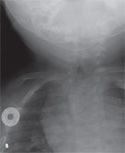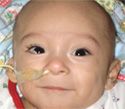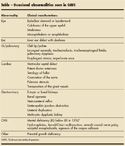Infant With Facial Anomalies
This 6-month-old infant, born at 29 weeks' gestation, was transferred to Childrens Hospital Los Angeles for evaluation of intermittent stridor and a history of poor feeding.

This 6-month-old infant, born at 29 weeks’ gestation, was transferred to Childrens Hospital Los Angeles for evaluation of intermittent stridor and a history of poor feeding. Examination revealed an epibulbar dermoid on his right eye, mild right hemifacial microsomia, and right microtia (Figure A).

Flexible laryngoscopy performed at the bedside demonstrated mild laryngomalacia.
Because of the above findings, a screening spine film was obtained. It showed multiple segmental vertebral body malformations in the cervical and thoracic spine (Figure B).
WHAT DIAGNOSIS CAN EXPLAIN THESE FINDINGS? (Answer on the next page.)
ANSWER: Oculo-Auriculo-Vertebral Spectrum (OAVS)

This infant has OAVS--a variable combination of facial anomalies that arise from defects in the development of the first and second branchial arches. Previously, OAVS was separated into several named entities, including hemifacial microsomia and Goldenhar syndrome. Classically, hemifacial microsomia was defined as a condition involving primarily ear, oral, and mandibular anomalies. Goldenhar syndrome was the name designated when the findings of hemifacial microsomia were also accompanied by vertebral anomalies and an epibulbar dermoid. While controversy surrounding the nomenclature continues, the term "oculo-auriculo-vertebral spectrum" summarizes different phenotypic expressions of a continuum and is now widely accepted.

OAVS is estimated to occur in 1 in 3000 to 5000 persons. There is a slight male predominance (3:2).1 Most cases are sporadic, although familial patterns with both autosomal-recessive and autosomal-dominant inheritance have been observed. Several hypotheses concerning the cause of OAVS exist. These hypotheses include a connection with maternal diabetes, exposure to teratogenic agents, a variety of chromosomal abnormalities, and embryonic hematoma formation.2-4 The exact cause of this disorder remains unknown and etiological heterogeneity is likely. The estimated recurrence risk is 2% to 3%, consistent with multifactorial determination.5
The Table shows the variable combination of manifestations that occur in OAVS. These manifestations tend to be unilateral; right-sided involvement of the face is more common than left. When the defects are bilateral, involvement is asymmetric.

Children with OAVS should undergo imaging studies of the heart and kidneys as well as hearing screens. Those with anophthalmia or micropthalmia are at higher risk for disability and should undergo brain imaging as well.2 Children should be referred to a center with a pediatric craniofacial team for consultation on the need for cosmetic surgery or feeding studies. Hypoplasia of the pharyngeal muscles and absent or hypoplastic salivary glands may cause early dysphagia and failure to thrive.
The vast majority of patients have normal intelligence and an excellent prognosis.
References:
REFERENCES:
1.
Jones KL. Spectrum of defects. In: Jones KL, ed.
Smith's Recognizable Patterns of Human Malformation.
6th ed. Philadelphia: Elsevier Saunders; 2006:738-741.
2.
Cohen MM, Rollnick BR, Kaye CI. Oculoauriculovertebral spectrum: an updated critique.
Cleft Palate J.
1989;26:276-286.
3.
Tasse C, Majewski F, Bohringer S, et al. A family with autosomal dominant oculo-auriculo-vertebral spectrum.
Clin Dysmorphol.
2007;16:1-7.
4.
Mason AC, Bentz ML, Losken W. Craniofacial syndromes. In:Zitelli BJ, Davis HW, eds.
Atlas of Pediatric Physical Diagnosis.
4th ed. St Louis: Mosby; 2002:814-815.
5.
Stoll C, Viville B, Treisser A, Gasser B. A family with dominant oculoauriculovertebral spectrum.
Am J Med Genet.
1998;78:345-349.